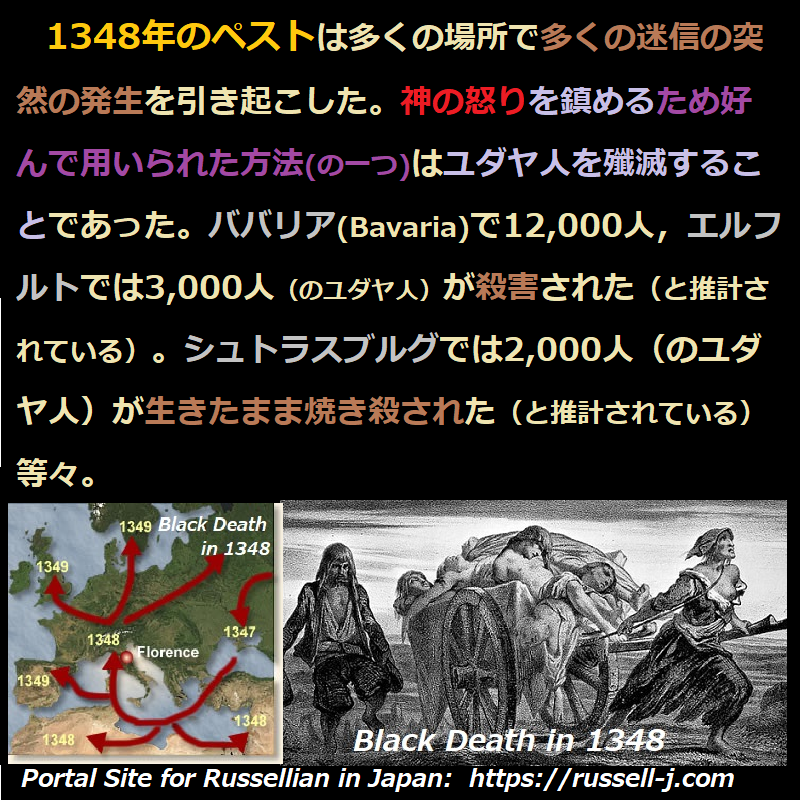
1348年のペストは,多くの場所で多様な迷信の突然の発生(突発)を引き起こした。神の怒りを鎮めるため好んで用いられた方法(の一つ)は,ユダヤ人を殲滅すること(destruction)であった。ババリア(Bavaria)で12,000人,エルフルトでは3,000人(のユダヤ人)が殺害された(と推測されている)。シュトラスブルグでは2,000人(のユダヤ人)が生きたまま焼き殺された(と推測されている)、等々。教皇のみがこのような気違いじみた虐殺に抗議した。ペストによって最も重大な影響をがもたらされたのはシエナにおいてであった(注:津田氏は,荒地出版社刊の訳書で “singular effect” を「奇妙な結果」と奇妙な訳をしている)。(シエナの被害の前に)シエナ大聖堂を大幅に拡張することが決められ,相当作業(工事)が既になしとげられていた。だが,シュナの住民たちは,他の地域での悲運(被害状況)を知らず(oblivious of),悪疫がやってくると,それ(ペスト)はこのような壮大な教会を持ちたいと思う彼らのうぬぼれ(pride)を罰するための,罪深いシエナの人々に対する神による特別な天罰であると考えた(想定した)。かれらは仕事を止めた。彼らは工事を中止し,未完の建物が今日に至るまで彼らの後悔の記念碑として残っている。 病気と闘う迷信的な方法が効果的だと広く信じられただけでなく,医学の科学的研究は厳しく阻止された。主な開業医はユダヤ人であり,彼らはその知識をイスラム教徒たち(マホメット教徒たち)から得ていた。(また)彼らユダヤ人は魔力を持っているのではないか -もしかすると彼らはその疑いをもしかすると黙従していたかも知れない。なぜならそう思われたほうが彼らの報酬が増したからである。かれらはそうした疑いに同意していたに違いない。解剖学(anatomy)は邪悪なものと考えられた。なぜなら,肉体が蘇ることを妨げる可能性があるため,また,キリスト教会が血を流すことを忌み嫌ったためである。解剖(dissection)は実質的に禁じられた。それは,ボニファティウス8世(Boniface VIII = Bonifatius VIII, 1235年頃 -1303年)の教皇勅書(Bull 回勅)についてのある誤解の結果であった。16世紀後半,教皇ピウス5世は,以前の教皇勅書(回勅)を改め,医者たちに「肉体の疾病はしばしば罪から生れる」ので,まず司祭を招き,3日以内に患者が司祭に(自分の罪について)告白しなかったらそれ以上の治療は拒否するようにと命じた。もしかすると(perhaps),当時の医学の遅れた状態を考えると彼の見解は賢明だったかも知れない。(注:津田氏は perhaps を「おそらく~だろう」と訳出している。”probably” は「多分」「おそらく」(確率が高い)であるが,”perhaps” は確からしさの確率には関係なく,「もしかすると」「ことによると」と訳すのが定訳となっている。「多分」「おそらく」と訳すとニュアンスがかなり異なってしまう。「罪を告白しなければ治療はおそらくやめたほうがよいだろう」なんて狂信者以外言わないと気づくべきであろう。)
Chapter 4: Demonology and Medicine, n.5 The Black Death, in 1348, caused outbreaks of superstition of various sorts in various places. One of the favourite methods of appeasing God’s anger was the destruction of Jews. In Bavaria, twelve thousand are reckoned to have been killed ; in Erfurt, three thousand ; in Strasburg, two thousand were burnt ; and so on. The Pope alone protested against these mad pogroms. One of the most singular effects of the Black Death was in Siena. It had been decided to enlarge the cathedral very greatly, and a considerable amount of the work had already been done. But the inhabitants of Siena, oblivious of the fate of other places, supposed, when the plague came, that it was a special visitation to the sinful Sienese, to punish them for their pride in wishing to have such a magnificent cathedral. They stopped the work, and the unfinished structure remains to this day as a monument of their repentance. Not only were superstitious methods of combating disease universally believed to be effective, but the scientific study of medicine was severely discouraged. The chief practitioners were Jews, who had derived their knowledge from the Mohammedans ; they were suspected of magic, a suspicion in which they perhaps acquiesced, since it increased their fees. Anatomy was considered wicked, both because it might interfere with the resurrection of the body, and because the Church abhorred the shedding of blood. Dissection was virtually forbidden, in consequence of a misunderstood Bull of Boniface VIII. Pope Pius V, in the latter half of the sixteenth century, renewed earlier decrees by ordering physicians first to call in the priest, on the ground that “ bodily infirmity frequently arises from sin,” and to refuse further treatment if the patient did not confess to the priest within three days. Perhaps he was wise, in view of the backward condition of medicine in those days.
出典:Religion and Science, 1935, chapt. 4:
情報源:https://russell-j.com/beginner/RS1935_04-050.HTM
